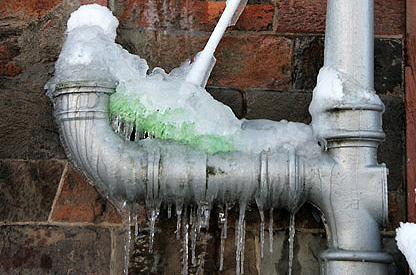They are making a number of great observations on the subject of Preventing and dealing with frozen pipes overall in this great article down the page.

Winter can wreak havoc on your pipes, especially by freezing pipes. Here's exactly how to avoid it from happening and what to do if it does.
Introduction
As temperatures decrease, the risk of icy pipes rises, possibly causing costly repair work and water damages. Understanding how to avoid icy pipelines is essential for house owners in cold climates.
Prevention Tips
Shielding prone pipelines
Cover pipelines in insulation sleeves or make use of warm tape to protect them from freezing temperature levels. Focus on pipelines in unheated or external locations of the home.
Home heating techniques
Maintain indoor areas properly heated, especially locations with plumbing. Open closet doors to permit warm air to circulate around pipelines under sinks.
Exactly how to identify icy pipes
Look for lowered water flow from taps, unusual smells or sounds from pipes, and noticeable frost on exposed pipelines.
Long-Term Solutions
Structural modifications
Take into consideration rerouting pipelines far from outside wall surfaces or unheated locations. Include additional insulation to attic rooms, basements, and crawl spaces.
Upgrading insulation
Invest in top quality insulation for pipes, attics, and wall surfaces. Appropriate insulation assists maintain consistent temperature levels and lowers the danger of frozen pipes.
Protecting Exterior Plumbing
Yard tubes and outside faucets
Separate and drain yard pipes before winter months. Set up frost-proof spigots or cover exterior faucets with protected caps.
Recognizing Frozen Pipelines
What triggers pipes to ice up?
Pipes ice up when exposed to temperatures listed below 32 ° F (0 ° C) for extended periods. As water inside the pipes ices up, it expands, putting pressure on the pipeline wall surfaces and possibly triggering them to rupture.
Risks and problems
Icy pipelines can cause water supply interruptions, residential or commercial property damage, and costly repair services. Ruptured pipelines can flood homes and trigger substantial structural damage.
Signs of Frozen Pipes
Identifying icy pipelines early can avoid them from bursting.
What to Do If Your Pipelines Freeze
Immediate activities to take
If you think frozen pipelines, keep faucets open up to eliminate pressure as the ice thaws. Utilize a hairdryer or towels soaked in warm water to thaw pipes gradually.
Final thought
Preventing icy pipelines needs proactive procedures and quick actions. By understanding the causes, indicators, and preventive measures, home owners can safeguard their pipes throughout cold weather.
5 Ways to Prevent Frozen Pipes
Drain Outdoor Faucets and Disconnect Hoses
First, close the shut-off valve that controls the flow of water in the pipe to your outdoor faucet. Then, head outside to disconnect and drain your hose and open the outdoor faucet to allow the water to completely drain out of the line. Turn off the faucet when done. Finally, head back to the shut-off valve and drain the remaining water inside the pipe into a bucket or container. Additionally, if you have a home irrigation system, you should consider hiring an expert to clear the system of water each year.
Insulate Pipes
One of the best and most cost-effective methods for preventing frozen water pipes is to wrap your pipes with insulation. This is especially important for areas in your home that aren’t exposed to heat, such as an attic. We suggest using foam sleeves, which can typically be found at your local hardware store.
Keep Heat Running at 65
Your pipes are located inside your walls, and the temperature there is much colder than the rest of the house. To prevent your pipes from freezing, The Insurance Information Institute suggests that you keep your home heated to at least 65 degrees, even when traveling. You may want to invest in smart devices that can keep an eye on the temperature in your home while you’re away.
Leave Water Dripping
Moving water — even a small trickle — can prevent ice from forming inside your pipes. When freezing temps are imminent, start a drip of water from all faucets that serve exposed pipes. Leaving a few faucets running will also help relieve pressure inside the pipes and help prevent a rupture if the water inside freezes.
Open Cupboard Doors
Warm your kitchen and bathroom pipes by opening cupboards and vanities. You should also leave your interior doors ajar to help warm air circulate evenly throughout your home.

I discovered that content on Winter Plumbing Precautions: Preventing Frozen Pipes when exploring the internet. I beg you take a moment to share this blog posting if you liked it. We treasure reading our article about Prevent Frozen Pipes .
Website